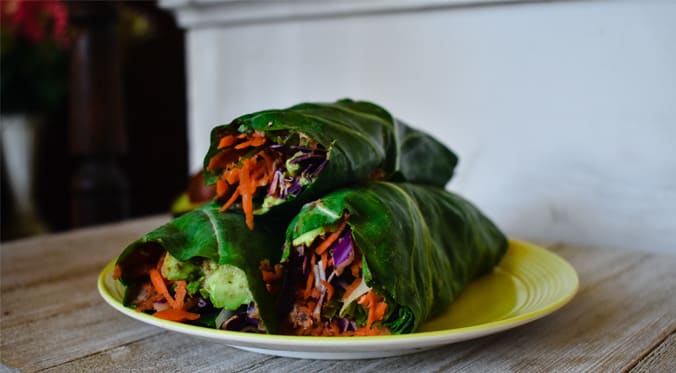Go Green with Collards

This recent recipe showcases collard greens, so let’s dig in to the benefits of leafy green vegetables! It is no surprise that salads are healthy, but you may or may not know about some of the deeper, darker varieties of greens that are considered super vegetables.
So, what makes something a “superfood”? Often, it’s as easy as looking at the color of your food.
Researchers have investigated the relationship between the depth of color of fruits and vegetables and their total amount of antioxidants and found a rough (though not perfect) correlation. For a real-world example, picture collard greens and celery. Which one is more colorful? To get as much vitamin C as you have in one cup of raw collard greens you would have to eat 10 stalks of celery. And then there’s trusty iceberg lettuce, the staple of the 1950s pre-dinner salad. Looking for vitamin A? You’d have to eat 7 times the amount of iceberg vs. collards to get an equal amount. Not a surprise, just based what we know about deeply-colored foods.
At a technical level, when gauging the potential benefits of foods, scientists explore many aspects of nutritional content including vitamins, minerals, phytochemicals, antioxidants, fiber and other key components. (Check out the definitions below.)
Superfoods are whole ingredients (often plant-based) that are nutritionally dense with these substances. For the average person, this can be a lot of info to measure and keep track of. Fortunately, the Centers for Disease Control and Prevention (CDC) published a guideline on what it calls “Powerhouse Fruits and Vegetables,” which it defines as “foods most strongly associated with reduced chronic disease risk.” Researchers ranked 47 common fruits and veggies in order of nutrient density to help better define which foods are the best to support your long-term health. Topping this list are more than 16 leafy green vegetables including:
– Spinach: Popeye was right! Rich in vitamins A, C, and K, magnesium, iron and manganese, this mighty leaf is delicious raw or cooked (especially with lots of garlic).
– Romaine Lettuce: This humble standard salad green boasts a healthy offering of fiber, folate, vitamins A, C, and K and a tasty crunch; and our star of this week,
– Collard Greens: This versatile green is full of fiber, antioxidants, calcium, vitamins A, C, and K, iron, and other key nutrients. It’s also a cruciferous vegetable, so it’s especially high in glucosinolates, which are converted by your body to antioxidant and anti-inflammatory compounds. Read more about broccoli (another member of the cruciferous family) and prostate cancer here.
Find more brightly-colored vegetables in our guide to eating, exercise, and rest: The Science of Living Well, Beyond Cancer.
Other Ways to Enjoy Collard Greens
Raw: Collard greens can be a delicious base for a crunchy salad or slaw. But they can be flavorless and tough without a little TLC first. To make your raw collards dish extra delicious, we recommend massaging to help break down the cellulose in plant cell walls and improve texture.
To prep, remove any tough center stems and slice the leaves thinly, like a slaw. To get the best texture, sprinkle the greens with a pinch of salt and a squeeze of lemon juice or a splash of your favorite vinegar. The acid will also help break down the cellulose. Rub together between your fingers and squeeze them until they just start to soften (don’t overdo it – mushy greens aren’t great either). You can also rinse after massaging to remove the bitter compounds that form when you break apart the plant cells. Now, your salad base is ready.
Consider adding your favorite sliced fruit and chopped nuts for a tasty salad. Or shredded carrots or jicama—the sweetness balances the vegetal flavor of the raw collards. Finish with a sprinkle of olive oil, more lemon juice or vinegar, and salt & pepper.
Braised: A popular preparation for collard greens is a low and slow braise in a highly flavorful liquid. Traditionally, collard greens are simmered for an hour or more in chicken stock with a chunk of salt pork, ham hocks, or bacon, and some garlic, red pepper flakes, or other seasonings. For a version with less saturated fat, try using a smoked turkey leg instead of the pork. If you want to go meat-free, you can use vegetable stock and swap in a big piece of parmesan cheese rind (and/or a few splashes of fish sauce) instead of the meat. (Just make sure to pull out the rind before you eat!). Add a dash of cider vinegar or hot sauce before serving to wake up the flavor.
Glossary of terms:
Antioxidants: substances that can prevent or slow damage to our body’s cells.
Fiber: also known as “roughage,” this includes the parts of foods your body can’t completely digest or absorb. Providing bulk in the gut, they can help with digestion generally, and even lower blood cholesterol and glucose levels. Fiber is food for your microbiome, the “good” bacteria that produce beneficial compounds for you if you feed them well!
Minerals: naturally-occurring substances that help our bodies develop and function normally. Those most essential for health include calcium, phosphorus, potassium, sodium, chloride, magnesium, iron, zinc, iodine, chromium, copper, fluoride, molybdenum, manganese, and selenium.
Phytochemicals: these are naturally occurring chemicals in plants; antioxidants are one example. Science is only just beginning to understand their potential, but these compounds may go a long way toward keeping us healthy and possibly even preventing and fighting disease.
Superfoods: a non-scientific term for unprocessed foods full of healthy compounds
Vitamins: substances that are needed for normal cell function, growth, and development. Some vitamins function as antioxidants. Fruits and vegetables are an excellent source for these compounds.









